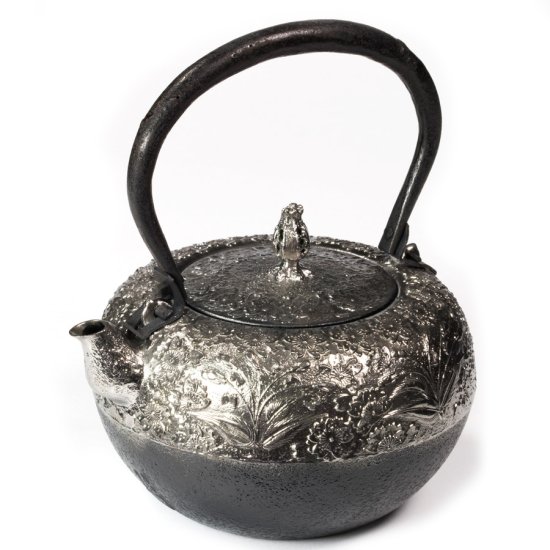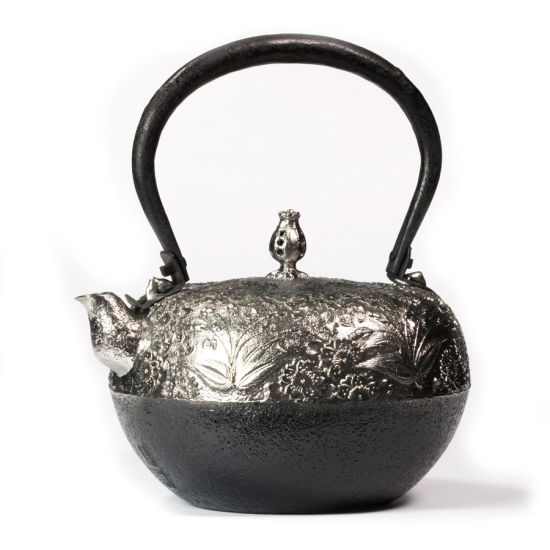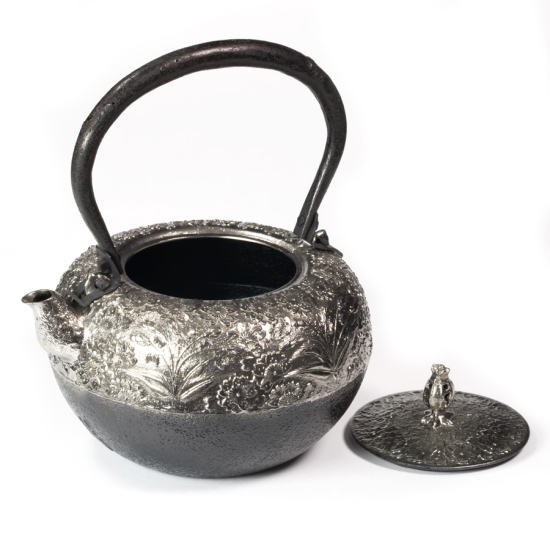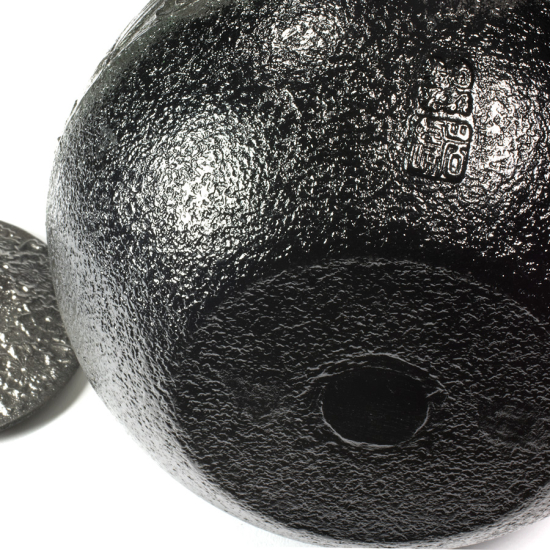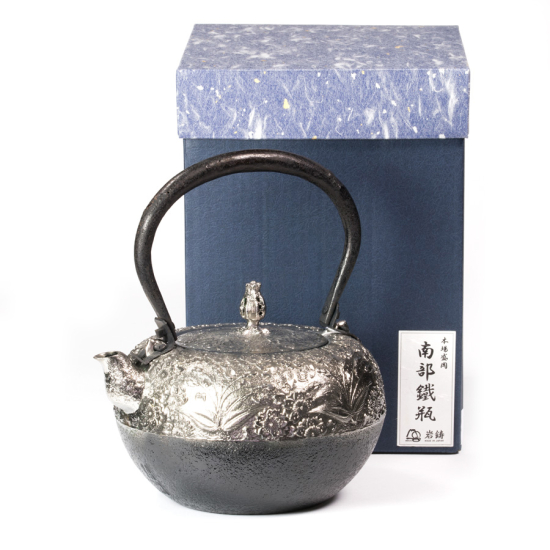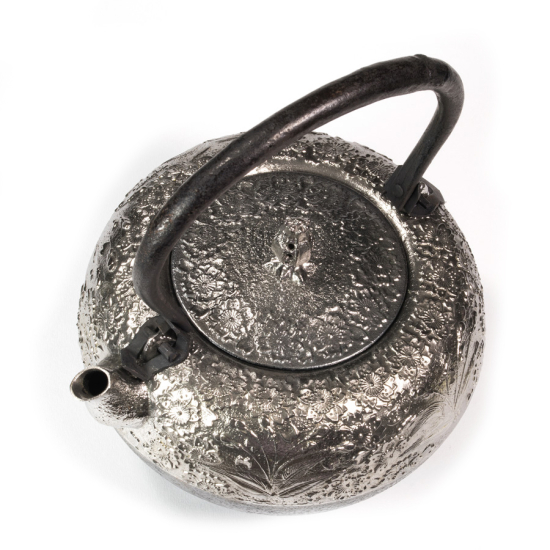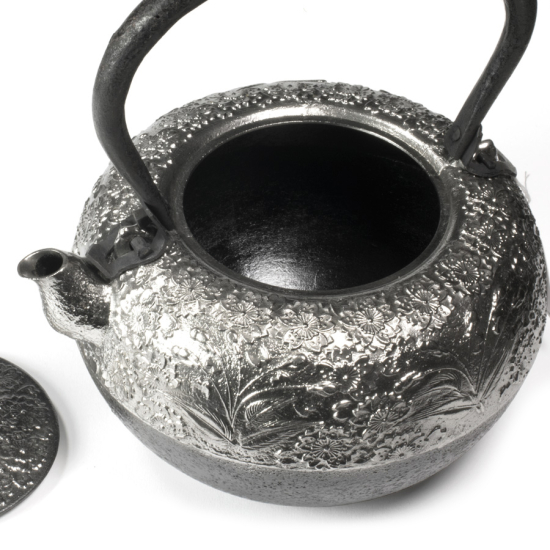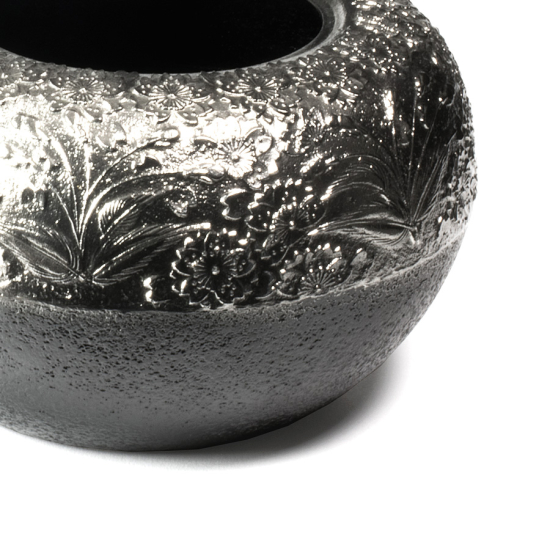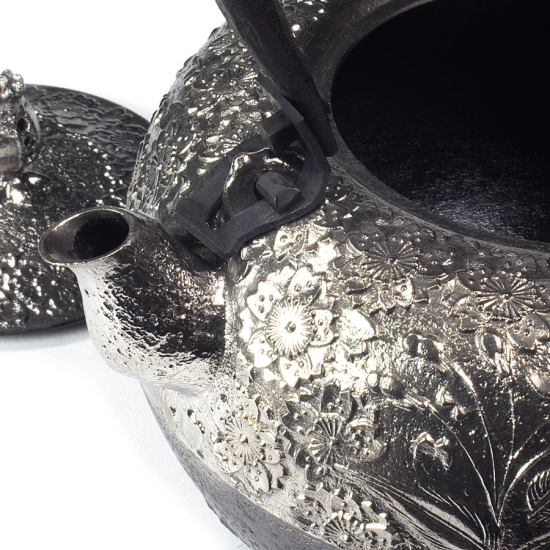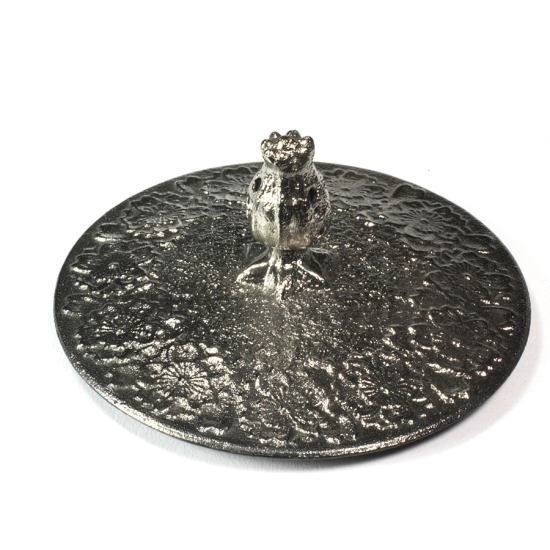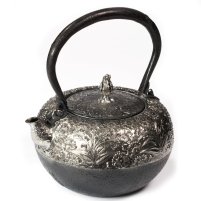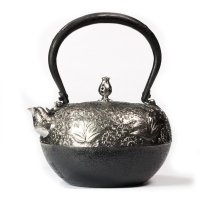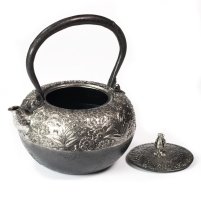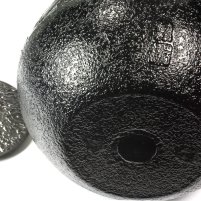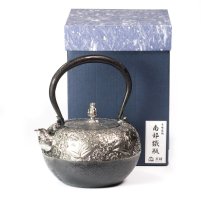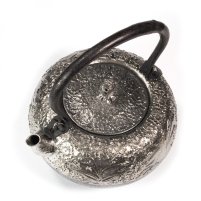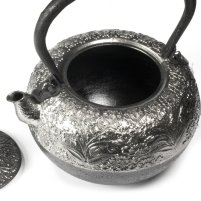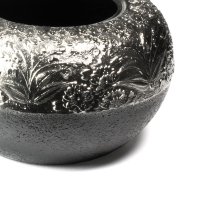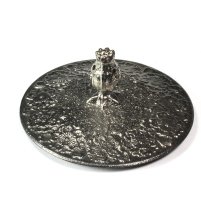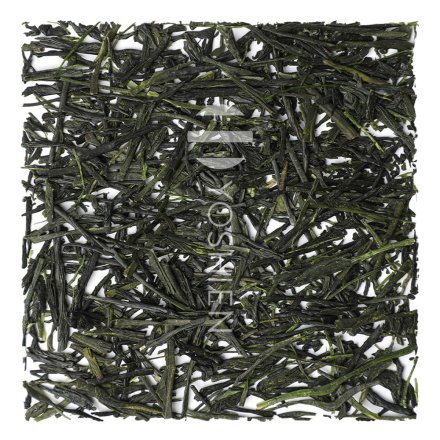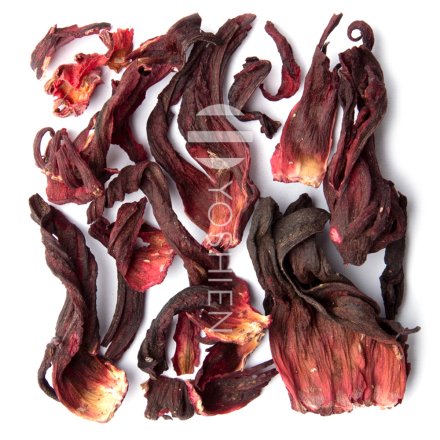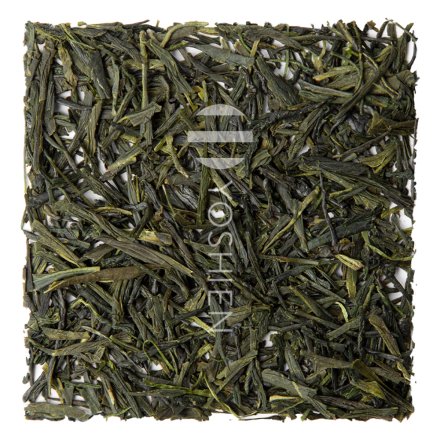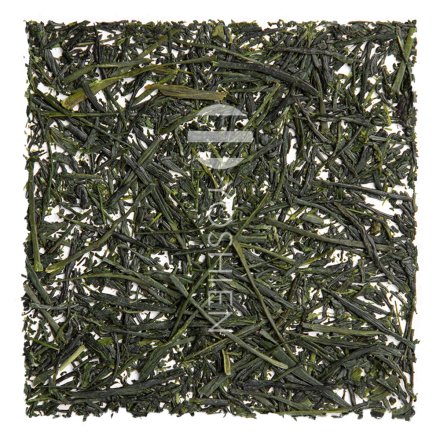The name Iwachu is synonymous with cast iron goods of the highest quality, and the brand's versatile product range extends from classic cast iron kettles (tetsubin), teapots (tetsu kyusu) and related accessories to bells, pans and much more. The manufacturer has boasted its own tradition since its founding in the Meiji period and throughout the 400-year-old Nanbu tekki tradition. It also has its own production line. Every step, from design planning to manufacturing to sales, is carried out by the company itself. Iwachu is dedicated to producing robust cast iron products with excellent functionality and contemporary design. Master casters at the company are required to undergo a minimum of 15 years of training, meaning that all products meet the highest quality standards.
Tetsubin
Satetsu
Sakura L
IWACHU
| Type | Nanbu Tekki tetsubin |
| Origin | Morioka, Iwate, Japan |
| Studio/Artist | Iwachu |
| Maximum Capacity | 1.9L |
| Dimensions | 20 x 17 x 23cm |
| Weight | 2.1kg |
| Material | Satetsu cast iron (ironsand) |
| Pattern | Sakura (桜; cherry blossom) |
| Coating | Naturally rust-resistant; only requires a natural lacquer (漆焼付仕上げ), fired on both the inside and the outside. Elaborate polishing on the upper exterior portion of the kettle |
| Stove Use | Suitable for use on electric stovetops as well as over small to medium gas-powered flames |
| Strainer | No strainer |
| Artist's Stamp | Iwachu stamp |
| Packaging | High-quality gift box from Iwachu |
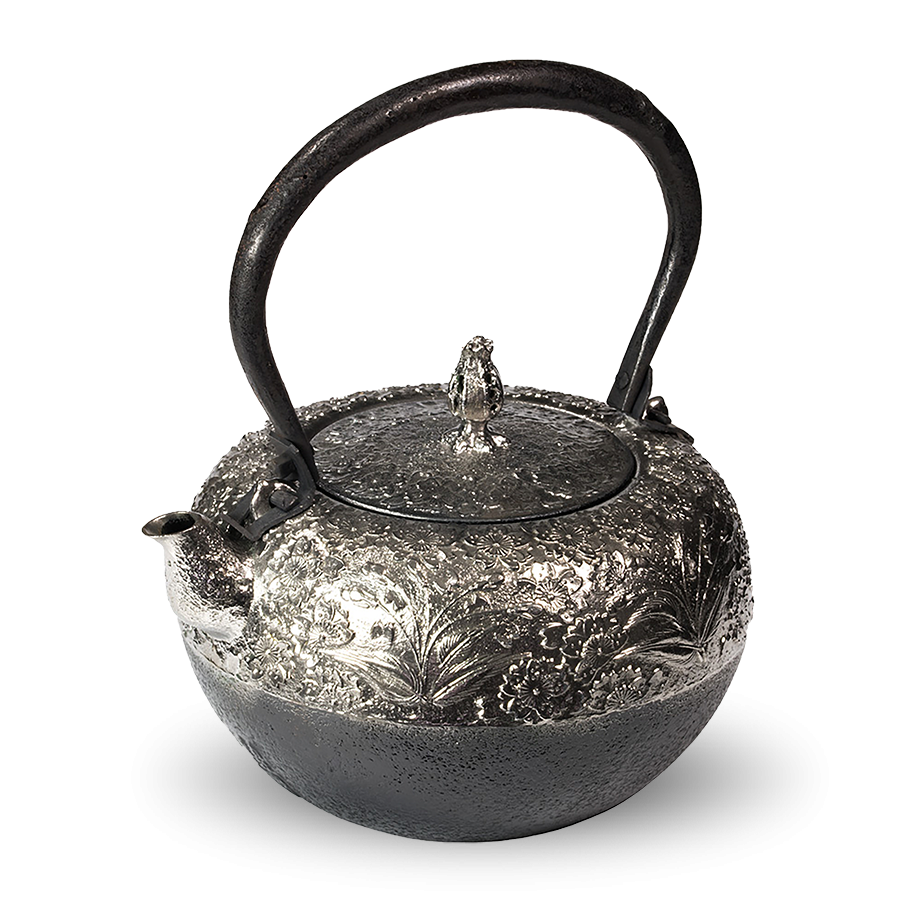
Tetsubin 鉄瓶
With their rustic charm, Japanese tetsubin can warm the heart as much as the tea water. These traditional cast iron kettles (the word "tetsu-bin" 鉄瓶 translates as "iron vessel") are used to boil water in the home for tea and cooking but are also commonly used in tea ceremonies. The iron, which is uncoated on the inside, mineralises and softens the water, thereby reducing the astringency of green tea and making infusions richer and sweeter. The origin of the tetsubin is uncertain, but it is almost certainly an evolution of the older chagama (茶釜), a large tea kettle without a spout or handle, heated on a brazier or in a hearth. As the tetsubin is easier to transport, it is typically chosen over the traditional chagama for outdoor tea ceremonies. Tetsubin are often decorated with ornate reliefs and come in various shapes and sizes, making them coveted collector's items for tea aficionados.
Satetsu tetsubins are considered the finest, rarest and most valuable of all cast iron kettles. Visually, they are also considered the most beautiful kettles in Japan. Satetsu is said to produce the best tasting water for tea preparation due to its special composition. It is much more resistant to rust than regular cast iron due to its low carbon content, and when it does rust, it is easier to remove. Satetsu also provides much better heat retention due to its density and is lighter, with a more delicate appearance. However, it is also more brittle than conventional cast iron and can more easily break when dropped. An interesting feature of satetsu tetsubins is their special resonance: they produce a clear, sharp sound when tapped lightly with a metal object and sing beautifully once the water they contain comes to a boil due to the high vibration that the boiling water creates in the kettle (after which they may be removed from the stove).

Nanbu Tekki 南部鉄器
The origins of Nanbu Tekki, or Nanbu ironware, can be traced back to the mid-17th century, when the Nanbu samurai clan were in need of Buddhist altars, bells and chagama teapots to furnish their newly built castle in Morioka, Iwate Prefecture, and so invited skilled metal casters from across the country to lend them a hand. Although the name Nanbu is written in kanji as "southern region", the clan ruled in the north of Japan, where materials needed for ironwork were naturally abundant. Highly durable, Nanbu Tekki is often deemed the best metalwork in Japan and makes beloved heirlooms—particularly cast iron kettles, or tetsubin, which are also highly sought after by collectors around the world. In 1975, Nanbu Tekki was designated the first certified Traditional Craft of Japan. The name Nanbu Tekki refers exclusively to cast iron products made in the cities of Morioka and Oshu.
Clay
Production
Manufactured by Hand
The extremely elaborate manual production requires a total of 6 months to complete. It includes hand forging a hollow handle and knob which remain cool when the kettle is in use on the stove. Characteristic of satetsu tetsubins, this refined water kettle has a beautiful, shiny silver surface due to the meticulous hand polishing of the exterior in the last step of the long manufacturing process.
Rust Protection
The extremely rust-resistant ironsand only requires a natural lacquer (漆焼付仕上げ), allowing the kettle to retain optimal iron permeability. In this way, the water is allowed to come into direct contact with the high-quality Japanese cast iron, enriching it with iron ions and improving its taste.
Satetsu 砂鉄
Only naturally sourced ironsand (satetsu; 砂鉄) from Japan is used for the kettle. Due to the high density of this particularly rust-resistant material, this kettle has high iron permeability and is naturally protected against rust, which is why satetsu tetsubin have always been considered the most precious of all tetsubin.
Compatibility
Can be used on electric stovetops as well as over low, gas-powered flames. Not suitable for use on an induction stove, in an oven or in a microwave.
Instructions for Use
Before using the tetsubin for the first time, please follow the manufacturer's instructions to prepare it: First, rinse the tetsubin and then fill it with hard water (preferably with a hardness level of about 300mg/L, e.g. that from Evian or Vittel) to about 80% of its full volume (adding more water will risk it boiling over). Place the tetsubin, with the lid on, over medium heat on a gas or electric stovetop (or on an induction stovetop if the model is compatible). Then, grasp the handle with a kitchen towel or potholder and carefully pour out the boiling water. Repeat this step 2–3 more times until the water, which may have taken on a different colour, pours clear and unclouded. Remove the lid and let the tetsubin dry on a trivet using its residual heat—never place an empty tetsubin on a hot stovetop. Now the tetsubin is ready for use. Once prepared, any water can be used in the tetsubin.
Notes: A protective layer of limescale forms inside the tetsubin during the preparation step as the calcium and magnesium contained in the hard water crystallises during boiling. This prevents rust from forming. With continuous use, reddish stains can form on the inside—these are harmless and should never be removed by rubbing, etc., as this would damage the tetsubin. Be sure to remove it from the stovetop as soon as the water finishes boiling to prevent the kettle from overheating and the water from boiling over. Important: Please never leave water in the tetsubin. Please also refer to our "Care" section for proper use.
Care
Please be sure to read our instructions for use before using the tetsubin for the first time. The kettle should never be in contact with water, hot or cold, for an extended period of time; this may cause rust to form. Do not put it in the microwave, oven or dishwasher. Use only plain water in the tetsubin; do not use it to brew tea. The maximum capacity of the tetsubin is 50–80% of its full volume. During use, ensure that the lid is either completely off or only slightly covering the opening to prevent the water from boiling over. Always leave the tetsubin to dry with the lid off. Do not rub or scour the inside of the tetsubin as this could damage the surface's limescale layer, which protects it against rust. Clean the outside of the tetsubin with a dry cloth or paper towel, and if it ever comes into contact with liquid between use, make sure to dry it off immediately. It is recommended to use the tetsubin frequently and store it in a well-ventilated place when not in use. Please do not drop it, as this may cause breakage despite its durability. If the water is cloudy or has an unpleasant metallic smell when boiling, fill the tetsubin 80% full with water and add a bag of sencha (either a conventional tea bag or loose-leaf sencha filled into a tea bag for this purpose). Boil for 30 minutes—the interaction of the tannins from the tea with the inner iron surface prevents the water from taking on a metallic character. Afterwards, pour the tea water out and boil it again with plain water, then drain it and let the tetsubin dry completely. Be sure to always place the tetsubin on a trivet when not in use on the stovetop to avoid any damage or discoloration to surfaces.



